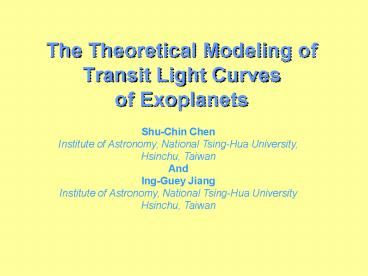The Theoretical Modeling of Transit Light Curves of Exoplanets - PowerPoint PPT Presentation
1 / 19
Title:
The Theoretical Modeling of Transit Light Curves of Exoplanets
Description:
To explore the possibility of different eccentricity. To be ready for our own observational data ... Eccentricity. 1.26 ( 0.07) RJ. Radius. 84.5( 0.6) deg. ... – PowerPoint PPT presentation
Number of Views:216
Avg rating:3.0/5.0
Title: The Theoretical Modeling of Transit Light Curves of Exoplanets
1
The Theoretical Modeling of Transit Light
Curvesof Exoplanets
Shu-Chin Chen Institute of Astronomy, National
Tsing-Hua University, Hsinchu, Taiwan And
Ing-Guey Jiang Institute of Astronomy, National
Tsing-Hua University Hsinchu, Taiwan
2
Outline
- Introduction
- general background
- detection methods
- Our goal
- The procedure
- theoretical model
- theoretical flux
- observational data fitting
- Future work
3
Introduction
- An extra-solar planet, or exoplanet, is a planet
beyond the Solar System. - The first confirmed detections were made in the
1990s since 2000, more than 15 have been
discovered every year, and the most in 2007 so
far. - The first milestone in the discovery of
extra-solar planets was in 1992, when Wolszczan
and Frail published results in the journal Nature
indicating that pulsar planets existed around
PSR B125712.
- Doppler Spectroscopy
- First planet discovered by radial velocity
method is 51 Pegasi b in 1995 - Transit Method
- First planet discovered by transit method is
OGLE-TR-56 b in 2000
4
Our Goal
- To develop an efficient method to calculate the
flux and fit the data. - To get better orbital solutions when new data is
available - To calculate the confidence level of each
solution - To explore the possibility of different
eccentricity - To be ready for our own observational data
5
Procedure
- To calculate the theoretical flux
- Search the most likely orbit from the data
- Fold the observational data
- Do chi-square fitting
- Get the best fit physical parameters of the
planetary system, such as rp, i, e, T - Draw the confidence level
p90
(ti,fi) N data points, I 1,.N
p60
fi observed flux fc theoretical flux p
dependent variables N the number of data
points s flux uncertainties.
p the percentage of probability
Confidence level can show us the possible
parameters distribution.
What we have done
6
The Limb-Darkening Effect
observer
?
r
1
No limb darkening For a uniform source, I(r) is
a constant.
With limb darkening, I(r) is a function of r.
7
The Method to Calculate the Flux
Un-obscured
covers the limb of the stellar disk
Sepgt1p
star
Sep-p
p
p
Sep-p
p rp/ rs the planet size ratio Sep
the normalized separation
8
The Method to Calculate the Flux
entirely within the stellar disk
0ltSepltp
Sep0
star
star
p
Sep-p
p
p-Sep
Sep
Sep p
9
HD189377 facts
The Example
Un-obscured
The planet covers the limb of the stellar disk
The planet lies entirely inside the stellar disk
10
I
11
The Orbital Model of HD189733
3D pictures demonstrate the planet position . 2D
pictures show the planet crosses the stellar
disk.
12
The Parameters
The effect of planetary size. The effect
of inclination.
The effect of planetary size. The
effect of inclination.
The effect of planetary size. The
effect of inclination.
13
OGLE-TR-10 System
The folded data from OGLE. The curves is
theoretical flux.
The folded data from OGLE. The curves is
theoretical flux.
14
The Original Data From OGLE
tigt2.45392HJDcontains 219 data points
15
Folded Data
period 3.1 days
- The two parameters we choose are planetary
size and inclined angle - We found the best-fit planetary size
- is 1.2 RJ and the inclination is 85 deg
The original data from OGLE.
The original data from OGLE
16
Confidence Region
??2 minimum (1.2, 85)
p68
p90
17
Conclusions
- Limb-darkening effect cannot be ignored.
- Different parameters have different effects on
light curves. - In our study, the best-fit planetary size is 1.2
RJ , - and the inclination we found is 85.0 deg.
- Parameters obtained in published paper, the
planetary is 1.26 ( 0.07) RJ, and the
inclination is 84.5 ( 0.6) deg.
18
Future Work
- We hope to use Levenberg-Marquardt Method to
determine best-fit parameters, and find the most
likely orbit. - In addition to the transit data, we will also use
the data of stars radial velocity to do the
fitting, to find even better orbits. - We will use our own observational data to find
other extra-solar planets.
19
Thank you for your listening!

